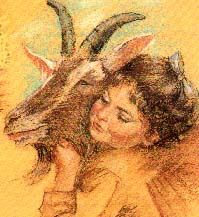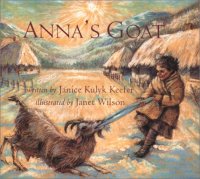|
________________
CM . . . .
Volume VII Number 14 . . . . March 16, 2001
excerpt: That night there was a knock at the door. When Anna's mother opened it, what should walk inside but a strange creature with four skinny legs, a fat, fleecy coat and a beard like a curl of cloud! Wanda stared and stared, and then looked up at her mother, asking the question just with her eyes.  Anna's Goat details the plight of a refugee family forced into the European countryside during
World War II and the unique way their adoptive village helps them cope with their desperate
circumstances. The story opens with the birth of baby Anna, whose arrival casts a bright glow
over the family's dark and unhappy exile. After the father leaves to work in another village and the
mother finds she can no longer feed her baby, the village women present them with a goat to
provide milk and comfort to the children. When the war ends and they are able to return to their
home in the city, Anna's goat must remain behind in the village to help feed other children. As
they begin the difficult process of rebuilding the ravished city, the children make a game of finding
treasures in the rubble. When Anna complains to her mother that she is unable to find a treasure,
she is given a half-chewed towel - a reminder of the nanny goat who kept her safe and warm in
the cold countryside. This object becomes Anna's treasure, and she sleeps each night with the
scrap of cloth and with the memory of the warm goat enveloping her dreams. The story ends with
a grown-up Anna, now living in Canada, creating clay sculptures of animals, and especially of
nanny goats.
Anna's Goat details the plight of a refugee family forced into the European countryside during
World War II and the unique way their adoptive village helps them cope with their desperate
circumstances. The story opens with the birth of baby Anna, whose arrival casts a bright glow
over the family's dark and unhappy exile. After the father leaves to work in another village and the
mother finds she can no longer feed her baby, the village women present them with a goat to
provide milk and comfort to the children. When the war ends and they are able to return to their
home in the city, Anna's goat must remain behind in the village to help feed other children. As
they begin the difficult process of rebuilding the ravished city, the children make a game of finding
treasures in the rubble. When Anna complains to her mother that she is unable to find a treasure,
she is given a half-chewed towel - a reminder of the nanny goat who kept her safe and warm in
the cold countryside. This object becomes Anna's treasure, and she sleeps each night with the
scrap of cloth and with the memory of the warm goat enveloping her dreams. The story ends with
a grown-up Anna, now living in Canada, creating clay sculptures of animals, and especially of
nanny goats.
Janet Wilson, an award-winning illustrator, again displays her amazing talent to portray faces realistically. However, she departs from her usual bright colours and finely detailed portraiture. Using Conte crayon on coloured paper, her soft sketches in muted colours, with their preponderance of browns and sepia tones, are reminiscent of old photos. These are perfectly suited to this subdued memoir of a dismal period. Janice Kulyk Keefer's reflective story reveals the adversity of the time, but the harsher realities of war are not introduced. Instead, Keefer lyrically presents one family's experience in which they are reunited with each other and their home at the end. Together, Keefer and Wilson have created a gentle and memorable portrait of refugee life. Anna's Goat is recommended for home use or classroom units on war or multiculturalism. Highly Recommended. Alison Mews is Head of the Curriculum Materials Centre at the Faculty of Education, Memorial University of Newfoundland in St. John's, NF.
To comment on this title or this review, send mail to cm@umanitoba.ca.
Copyright © the Manitoba Library Association.
Reproduction for personal use is permitted only if this copyright notice
is maintained. Any other reproduction is prohibited without
permission.
Published by
TABLE OF CONTENTS FOR THIS ISSUE - March 16, 2001.
AUTHORS |
TITLES |
MEDIA REVIEWS |
PROFILES |
BACK ISSUES |
SEARCH |
ORDER |
CMARCHIVE |
HOME
|
